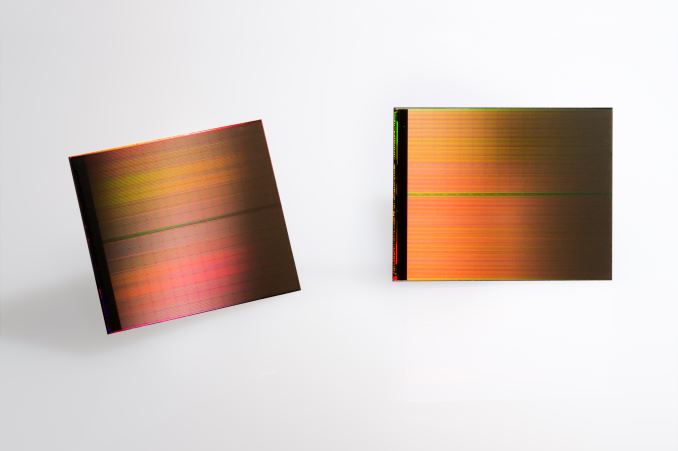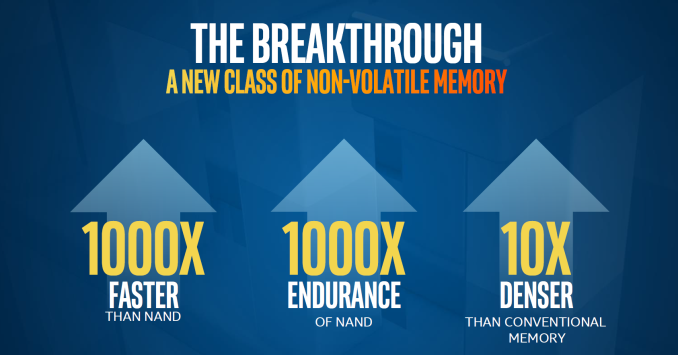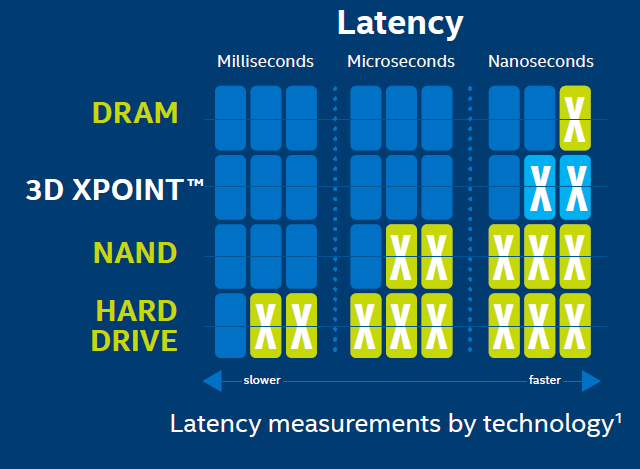Analyzing Intel-Micron 3D XPoint: The Next Generation Non-Volatile Memory
by Kristian Vättö, Ian Cutress & Ryan Smith on July 31, 2015 11:00 AM EST
The current mainstream memory technologies, namely DRAM (quick memory accessed by the processor) and NAND (solid-state storage), have been around for decades. While the cell designs have evolved over the years to allow scaling to 20nm and below, the fundamental physics behind DRAM and NAND operation haven't changed a bit and both technologies have their unique technological limitations. DRAM offers nanosecond-level latency and unlimited endurance, but this comes at the cost of large cell size, cell volatility, and power consumption. Since DRAM cells need to be constantly refreshed, the cells don't retain data in an off state, requiring quite a bit of power and making DRAM unsuitable for permanent storage. NAND, on the other hand, has much higher latency (especially write operations) and has a limited number of write cycles, but the cells are non-volatile and the structure is much more efficient, enabling low cost and suitability for storage.
Combining DRAM and NAND at the system-level architecture provides the best of both worlds, which is why modern computers use DRAM as a memory/cache and NAND for storage. However, there's still a latency and capacity gap between DRAM and NAND, so the question arises: what if you were to combine the best of DRAM and NAND at the silicon level? The mission of next generation memory technology across the industry has been to develop a new type of memory that provides low latency and high endurance while offering a small and scalable cell size.
We have seen numerous startups, such as Crossbar and Nantero, discuss and demonstrate their next generation memory technologies, but we have yet to see the established DRAM and NAND vendors come out with their solutions. Intel and Micron are here to change that with the announcement of their new 3D XPoint (Cross Point) non-volatile memory technology this week.
First and foremost, Intel and Micron are making it clear that they are not positioning 3D XPoint as a replacement technology for either NAND or DRAM, and in that scale it has been talked about more in its applications nearer NAND than DRAM. It's supposed to complement both and provide a technology that sits in between the two by filling the latency and cost gap exists between DRAM and NAND. Basically, 3D XPoint is a new tier in the computer architecture because it can be used as either slower, non-volitile memory or much faster storage.
| DRAM | 3D XPoint | NAND | |
| Endurance (P/E Cycles) | 10^15 | 10^7 | 10^3 |
| Read Latency | Nanoseconds | 10s of Nanoseconds | ~100 Microseconds |
Intel and Micron are claiming that 3D XPoint provides up to a thousand times higher endurance than NAND. Assuming that the numbers are relative to modern (15-20nm) MLC NAND, the endurance should be in the order of a few million P/E cycles; though the marketing materials are claiming up to tens of millions of write cycles. If we assume 3 million write cycles (1000x of what modern MLC has), a 256GB 3D XPoint based drive would have a total write endurance of 768 petabytes. That's equivalent to 420TB per day for five years, or 4.9GB per second. For storage applications that currently rely on NAND, 3D XPoint will eliminate any potential endurance concerns, but it's not durable enough to challenge DRAM in that front since DRAM endurance is essentially infinite. Whether 3D XPoint provides enough endurance to replace DRAM ultimately depends on the application, but especially in certain enterprise workloads there's a need for DRAM.
3D XPoint latency should be in the order of 10s of nanoseconds, but the companies didn't specify whether this is read or write latency. Judging by the graphs provided by Intel, it seems to be read latency because NAND write latency would measured in milliseconds (typically 1-2ms for a full page write), whereas the graph puts NAND latency at tens of microseconds that is in line with NAND read latency. Write latency is likely higher than that, probably at least 100s of nanoseconds or even a few microseconds given Intel and Micron's claims of "up to 1000x faster than NAND", but what complicates things is that 3D XPoint is accessible at the bit-level whereas NAND is page-level, so comparing the latency of the two without extended context is quite difficult. In any case, 3D XPoint performance should be closer to DRAM than NAND, but since Intel and Micron aren't discussing any specific latencies yet it's too early to make any final conclusions.
Meanwhile unlike many next generation memory technologies out there at the moment, 3D XPoint is the furthest along and doesn't only exist on paper or in a lab. Intel and Micron are currently sampling the first generation die that is being produced at the companies' jointly owned fab in Lehi, Utah. The die is 128Gbit (16GB) in capacity, whereas the products that startup memory companies have in production are in the order of dozens of megabytes. The die is built on a 20nm node and consists of two layers, and in the future scaling will happen through both lithography shrinks and by increasing the number of layers.
The Utah fab has been producing 20nm NAND for now since Intel didn't invest on the 16nm shrink and all initial 3D NAND production will take place in Micron's Singapore fab, but it's unclear whether the full fab with its 20,000 wafers per month capacity will be dedicated to 3D XPoint from now on. My guess would be that 3D XPoint will gradually take over the full wafer capacity in Utah depending on how the market reacts to the new technology and how high demand Intel and Micron are seeing. 3D XPoint does require some new equipment for manufacturing since 3D XPoint deals with a whole new set of materials, but Intel and Micron said that the transition is quite similar to a new NAND node and allows some of the existing equipment to be used.
The companies aren't quoting any price per gigabyte yet, but since the whole function of 3D XPoint is to fill the gap between DRAM and NAND, it will also be priced accordingly. A quick look at NewEgg puts DRAM pricing at approximately $5-6 per gigabyte, whereas the high-end enterprise SSDs are in the range of $2-3. While client SSDs can be had for as low as $0.35, they aren't really a fair comparison because at least initially 3D XPoint will be aimed for enterprise applications. My educated guess is that the first 3D XPoint based products will be priced at about $4 per gigabyte, possibly even slightly lower depending on how DRAM and NAND pricess fall within a year.












80 Comments
View All Comments
failquail - Friday, July 31, 2015 - link
Thinking about it, wouldn't an ideal use for this sort of memory be to use it as write-cache for storage devices? Almost as fast as RAM and does not need any sort of battery backup encase of power failures. Sounds perfect :)melgross - Friday, July 31, 2015 - link
I don't agree with the assumptions in the article about how this won't be a good replacement for current SSDs, because of cost. What I see here is that the prices,for,this arrive right at the price range of current SSDs. Yes, they are higher price SSDs, but still, not higher.It seems that the lesson of technology is lost here. All Tech becomes cheaper. It's almost as though the writers have forgotten that the first SSDs cost $3,600 for 32GB drives. HD prices have continued to fall, but not nearly as fast as that of SSDs.
Apple has almost all of their computers using SSDs, and that has certainly helped. They also use a major portion of the world's supply of NAND in their iOS devices. I'm not plugging Apple here, just pointing out that a major consumer company can affect usage and pricing dramatically.
If Apple, or some other major manufacturer decides that this Tech is just what they need, and begin to use it, then prices will begin to,drop,faster than otherwise thought.
I believe that this is a very good candidate for NAND drive substitution. And I feel as though it will begin happening more quickly than the writers here think it will.
Oxford Guy - Saturday, August 1, 2015 - link
Tech becomes cheaper as volume increases and manufacturing improves but SSD NAND will also become cheaper. So it remains to be seen how well this technology will drop in comparison with SSD NAND. Many people are still using 5400 RPM hard disks in their laptops so it is also not clear if there will be anything to compel regular people into buying something faster than an SSD and a higher price.abufrejoval - Friday, July 31, 2015 - link
I believe you’re falling into a marketing trap, when you imply that 32-layer Flash has 32x the capacity of planar flash (or 48-layer 48x capacity).When flash vendors talk about 3D Flash layers they are actually talking about process layers and it takes about 8 of them to implement a full logical storage plane. So 32 layer NAND simply has quad planar capacity and 48 layers six times the capacity of a planar chip at the same process size.
And since in the past 3D V-NAND was used to stay on the higher geometry node for endurance, actual capacity gain was even lower.
Intel/Microns bending technique was another way to retain surface area at lower geometries.
And as the V- in the V-NAND implies, you can’t stack silicon layers with complete freedom, even if processing cost were no issue. They were building terraces originally, something that the Toshiba 3D process avoids.
Still 100 or 1000 layers won’t happen on silicon, because that’s like building a skyscraper using mud bricks.
However, that’s not an issue with HP’s Memristor device, because that’s not a silicon process and layers of titanium dioxide can be slapped on top of each other without any crystalline alignment issues or deposition/etching limitations.
That is one of the enduring limitations of Xpoint vs. Memristor, the fact that it seems to remain a silicon based process, which means it doesn't allow anywhere the number of layers that a non-crystalline process can do.
And since the cost per layer is close to linear and high on silicon, that means it fails to deliver Moore's promise economically.
Kristian Vättö - Monday, August 3, 2015 - link
I'm well aware that 3D NAND uses a much larger lithography and the density per layer is far from planar NAND. I apologize if it reads differently, but that was unintentional, not a praise talk for 3D NAND.I think 100 layers will happen given that we are already close to 50 layers, but I agree that 1,000 layers would require a more significant change to the manufacturing process and materials.
abufrejoval - Friday, July 31, 2015 - link
My biggest fear with Xpoint is that Intel is attempting to create a de-facto monopoly around the NV-RAM space. They seem to have made a deal with HP for HP to delay the Memristor in return for some very favorable conditions on Xpoint, CPUs and whatever else HP needs to produce servers.An open price war between Memristor based and Xpoint based DDR4 DIMMs with hundreds of gigabytes if not terabyte capacity would have left half the industry bleeding to death, Intel would have lost against HP technologically, because the Memristor scales better in 3D, retains data indefinitely and has no endurance issues at all (also better latency, potentially even beating DRAM), but might have taken perhaps a little longer to get there.
And with Intel as an enemy and HP's current financial stand, there is a good chance they would have bled out on day 1 of that war.
So they agreed that is was better for both parties to delay the Memristor and give Intel a full run with Xpoint to recoup their investments and let HP regain some health and headstart against Lenovo, Dell and SuperMicro, who have no Memristor on the back burner to negotiate back channel rebates with Intel.
The only problem is that even if Xpoint looks like DDR4 RAM on the memory bus, it will require wear management, special initialization etc. via a control channel like SPI and in the BIOS.
Good luck trying to license that from Intel if you're a maker of ARM, AMD, p-Series or even z/Arch CPUs.
Intel gave up DRAM, because it was cut-throat commodity decades ago, but these days winds up making far less money off a standard big data server than DRAM manufacturers, even after they've pushed everybody else off the motherboard (Intel may make more profit, though).
XPoint not only gives them back the biggest slice on the server cake, and at a price they can move as close to DRAM as they want, while their production cost may actually be far lower, but it also eliminates all these pestly little ARM competitors as well as finishes big iron for once and for all for lack of a competitive memory solution.
What was probably a smart tactical move for HP, puts the future of the IT industry at risk because Intel has years of a practical, but thanks to Micron not legal, monopoly.
mdriftmeyer - Saturday, August 1, 2015 - link
Micron is on the verge of a hostile takeover of $23 Billion. This Joint Intel/Micron announcement came 3 days after that takeover bid.Sorry, but silicon is not the future, but the past. HP is in the driver seat with the Memristor. Once they fire Meg and hire an engineering board/ceo leveraging their IP will make Intel one unhappy camper.
lordken - Sunday, August 2, 2015 - link
Unfortunately I dont see HP (ES) is firing Meg anytime soon, she is going to HP ES as CEO...So I think that best chance to stuff her off was during separation where she should rather go to HP Ink rather then ES.Would not hold my breath for hope that HP would get good ceo, just look on couple of recent ceos we had...
Michael Bay - Sunday, August 2, 2015 - link
Memristor as technology is dead, HP is swithcing off from it. So there is no need for Intel to have any kind of dealing with them.Khenglish - Saturday, August 1, 2015 - link
I struggle to see the purpose of this memory. While flash is much slower, latency is limited by the controller. If you put this 3d XPoint memory in an SSD, you gain very little in performance since the controller was the bottleneck anyway. Flash manufacturers can get much higher performance from the memory out of a NOR design at the cost of some density, but they don't do it because again the controller is the issue. All I really see this being used for is business applications where flash memory's endurance is too low to be suitable.Also the term NAND only refers to the architecture of a memory system. I would not be surprised at all if 3D XPoint was also a NAND architecture. You might want to call the current tech flash or floating gate instead.